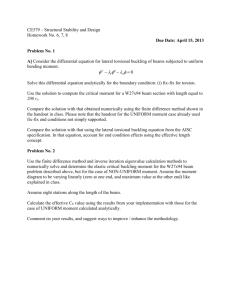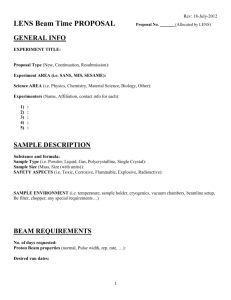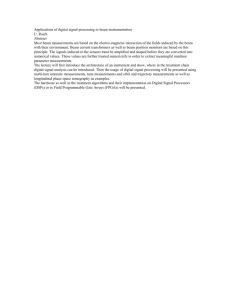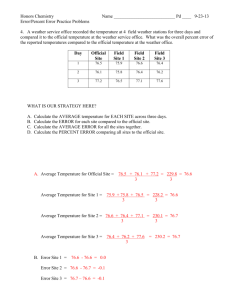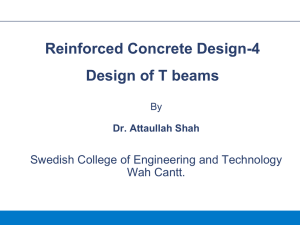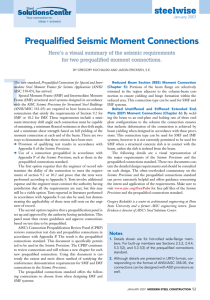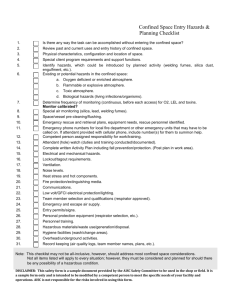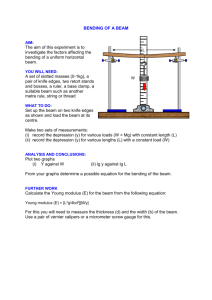steelwise - Modern Steel Construction
advertisement
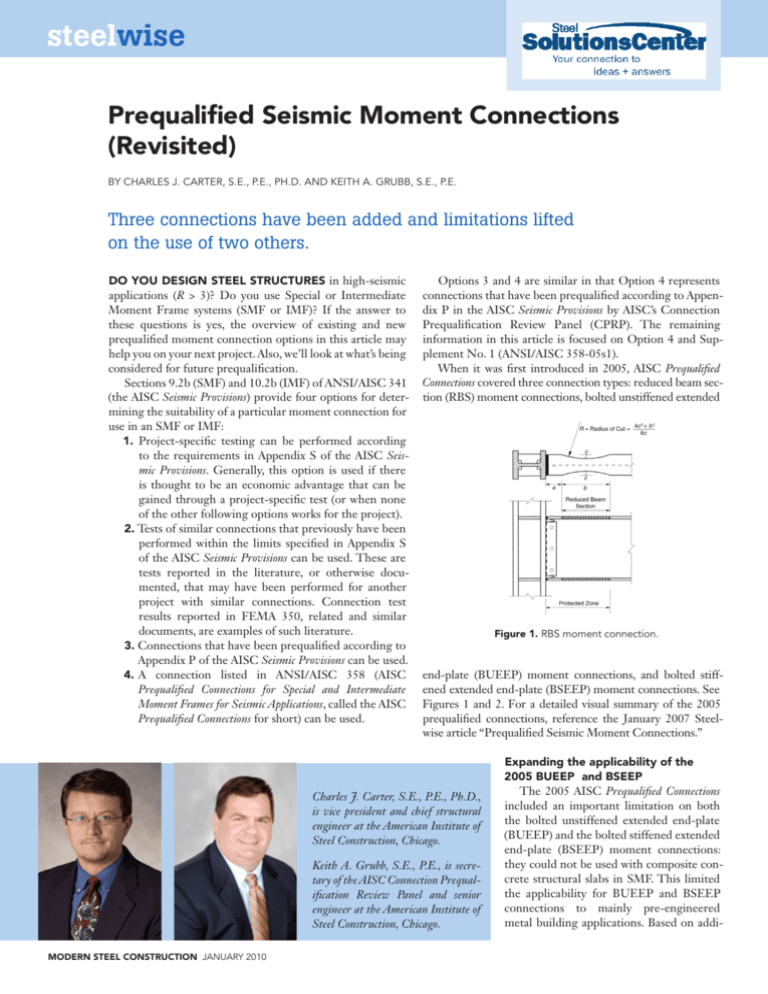
steelwise Prequalified Seismic Moment Connections (Revisited) By Charles J. Carter, S.E., P.E., Ph.D. and Keith A. Grubb, S.E., P.E. AISC_Prequalified_1 1/27/07 7:02 AM Page 15 Three connections have been added and limitations lifted on the use of two others. CHAPTER 5 6.2– 15 REDUCED BEAM SECTION (RBS) Do you design steel structures in high-seismic applications (R > 3)? Do you use Special or Intermediate Moment Frame systems (SMF or IMF)? If the answer to these questions is yes, the overview of existing and new prequalified moment connection options in this article may help you on your next project. Also, we’ll look at what’s being considered for future prequalification. Sections 9.2b (SMF) and 10.2b (IMF) of ANSI/AISC 341 (the AISC Seismic Provisions) provide four options for determining the suitability of a particular moment connection for use in an SMF or IMF: 1. Project-specific testing can be performed according to the requirements in Appendix S of the AISC Seismic Provisions. Generally, this option is used if there is thought to be an economic advantage that can be gained through a project-specific test (or when none of the other following options works for the project). 2. Tests of similar connections that previously have been performed within the limits specified in Appendix S of the AISC Seismic Provisions can be used. These are tests reported in the literature, or otherwise documented, that may have been performed for another project with similar connections. Connection test results reported in FEMA 350, related and similar documents, are examples of such literature. 3. Connections that have been prequalified according to Appendix P of the AISC Seismic Provisions can be used. 4.A connection listed in ANSI/AISC 358 (AISC Prequalified Connections for Special and Intermediate Moment Frames for Seismic Applications, called the AISC Prequalified Connections for short) can be used. CONNECTION Options 3 andMOMENT 4 are similar in that Option 4 represents connections that have been prequalified according to Appen5.1 General In a AISC reduced beam section (RBS) moment connection (Figure 5.1), portions dix P in the Seismic Provisions by AISC’s Connection of the beam flanges are selectively trimmed in the region adjacent to the beamPrequalification Review Panel (CPRP). The remaining to-column connection. Yielding and hinge formation are intended to occur primarily within the reduced section of the beam. information in this article is focused on Option 4 and Supplement No. 1 (ANSI/AISC 358-05s1). 5.2 Systems connections are prequalified for use in special moment frame (SMF) and inWhen itRBS was first frame introduced 2005, Prequalified termediate moment (IMF) systems in within the limitsAISC of these provisions. Connections covered three connection types: reduced beam sec5.3 Prequalification Limits tion (RBS) moment connections, bolted unstiffened extended Fig. 5.1. Reduced beam section connection. Figure 1. RBS moment connection. Prequalified Connections for Special and Intermediate Steel Moment Frames for Seismic Applications AMERICAN INSTITUTE OF STEEL CONSTRUCTION, INC. end-plate (BUEEP) moment connections, and bolted stiffened extended end-plate (BSEEP) moment connections. See Figures 1 and 2. For a detailed visual summary of the 2005 prequalified connections, reference the January 2007 Steelwise article “Prequalified Seismic Moment Connections.” Charles J. Carter, S.E., P.E., Ph.D., is vice president and chief structural engineer at the American Institute of Steel Construction, Chicago. Keith A. Grubb, S.E., P.E., is secretary of the AISC Connection Prequalification Review Panel and senior engineer at the American Institute of Steel Construction, Chicago. MODERN STEEL CONSTRUCTION january 2010 Expanding the applicability of the 2005 BUEEP and BSEEP The 2005 AISC Prequalified Connections included an important limitation on both the bolted unstiffened extended end-plate (BUEEP) and the bolted stiffened extended end-plate (BSEEP) moment connections: they could not be used with composite concrete structural slabs in SMF. This limited the applicability for BUEEP and BSEEP connections to mainly pre-engineered metal building applications. Based on addi- tional testing, the CPRP was able to remove this limitation in Supplement No. 1. BUEEP and BSEEP moment connections can now be used with composite slabs in SMF. In the connection, the beam is welded to an extended end-plate, which then AISC_Prequalified_1 1/27/07 is 7:02 AM bolted Page 23 to the column in one of three specified configurations as provided in AISC 358-05. Supplement No. 1 thus allows moment end plates to be 6.2– 23 considered for use in the majority of buildings. Also thanks to Supplement No. 1 to ANSI/AISC 358-05, CHAPTER 6 three more connection types now are prequalified; SuppleBOLTED AND STIFFENED ment No. 1UNSTIFFENED adds prequalified details for boltedEXTENDED flange plate END-PLATE MOMENT CONNECTIONS (BFP) moment connections, welded unreinforced flangewelded web (WUF-W) moment connections, and Kaiser 6.1 General bolted bracket (KBB) moment connections. See Figures 3, Bolted end-plate connections are made by welding the beam to an end-plate and end-plate to a column flange. The three end-plate configurations 4, and 5.bolting The the latter connection is a proprietary connection shown in Figure 6.1 are covered in this section and are prequalified under the detail that uses cast steel brackets. AISC Seismic Provisions within the limitations of this Standard. The behavior of this type of connection can be controlled by a number of different BFP Moment limit states Connections including flexural yielding of the beam section, flexural yielding of the end-plates, yielding of the column panel zone, tension failure of the endAs shown in Figure 3, bolted flange plate (BFP) moment plate bolts, shear failure of the end-plate bolts, or failure of various welded conconnections plates toprovided column with nections.use The intent of thewelded design criteria here isflanges to provide sufficient strength in the elements of the connections to ensure that the inelastic deformacomplete-joint-penetration (CJP) groove welds and bolted tion of the connection is achieved by beam yielding. to beam flanges with high-strength bolts. The beam web is 6.2 Systems connected to the column flange using a bolted single-plate Extended end-plate connections are prequalified for use in special moment frame shear connection with bolts in short-slotted holes. Inelas(SMF) and intermediate moment frame (IMF) systems. tic rotation is intended to occur in the beam in the region Exception: SMF systems in direct contact with concrete structural slabs are not near theprequalified. end of the flange plates. (a) Four-Bolt Unstiffened, 4E (b) Four-Bolt Stiffened, 4ES (c) Eight-Bolt Stiffened, 8ES Fig. 6.1. Extended end-plate configurations. Figure 2. BUEEP and BSEEP moment connections. The flange plates and web shear plate are shop welded to the column flange and field bolted to the beam flanges and web, respectively. ASTM A490 or A490M bolts with threads excluded from the shear plane are used for the beam flange connections because the higher shear strength of the A490 or A490M bolts reduces the number of bolts required and reduces the length of the flange plate. The shorter flange plates that are therefore possible reduce the seismic inelastic deformation demands on the connection and simplify the balance of the resistances required for different failure modes in the design procedure. Flange plate connections with A325 or A325M bolts may be possible, but will be significantly more difficult to accomplish because of the reduced bolt strength, greater number of bolts, and longer flange plates required. As a result, the connection is not prequalified for use with A325 or A325M bolts. The fundamental seismic behaviors expected with BFP moment connections include: 1. initial yielding of the beam at the last bolt away from the face of the column; 2.slip of the flange plate bolts, which occurs at similar resistance levels to the initial yielding in the beam flange, but the slip does not contribute greatly to the total deformation capacity of the connection; 3.secondary yielding in the column panel zone, which occurs as the expected moment capacity and as strain hardening of beam hinge occurs; and, 4.limited yielding of the flange plate, which may occur at the maximum deformations. This sequence of yielding has resulted in very large inelastic deformation capacity for BFP moment connections, but the design procedure is somewhat more complex than some other prequalified connections. WUF-W Moment Connections As shown in Figure 4, welded unreinforced flangewelded web (WUF-W) moment connections utilize CJP groove welds to connect the beam flanges to the column Protected Zone = S + d h Prequalified Connections for Special and Intermediate Steel Moment Frames for Seismic Applications AMERICAN INSTITUTE OF STEEL CONSTRUCTION, INC. Shims, if required Single-Plate Web Connection Continuity and Doubler Plates as Required d Shims, if required Fig. 7.13.Bolted plateconnection. moment connection. Figure BFP flange moment Protected Zone d Figure 4. WUF-W moment connection. Fig. 8.1. WUF-W moment connection. january 2010 MODERN STEEL CONSTRUCTION flanges. The beam web is bolted to a single-plate shear connection for erection. Subsequently, this plate is used as a backing bar for a CJP groove weld between the beam web and the column flange. A fillet weld also is used as shown in Figure 4. Inelastic rotation is intended to occur in the beam in the region adjacent to the face of the column. Connection fracture is controlled through special detailing requirements associated with the welds joining the beam flanges to the column flange, the welds joining the beam web to the column flange, and the shape and finish of the weld access holes. The welded unreinforced flange-welded web (WUF-W) moment connection is an all-welded moment connection, wherein the beam flanges and the beam web are welded directly to the column flange. A number of welded moment connections that came into use after the 1994 Northridge Earthquake, such as the reduced beam section and connections provided with beam flange reinforcement, were designed to move the plastic hinge away from the face of the column. In the case of the WUF-W moment connection, the plastic hinge is not moved away6.1–40 from the face of the column. Rather, the WUF-W moment connection employs design and detailing features that are intended to permit the connection to achieve SMF performance criteria without fracture. The beam flanges are welded to the column flange using CJP groove welds that meet the requirements of demand critical welds in the AISC Seismic Provisions, along with specific requirements for treatment of backing and weld tabs and welding quality control and quality assurance requirements. The beam web is welded directly to the column flange using a CJP groove weld that extends the full-depth of the web (that is, from weld access hole to weld access hole). This is supplemented by a single-plate connection, wherein a single plate is welded to the column flange and is then fillet welded to the beam web. Consequently, the beam web is attached to the column flange with both a CJP groove weld and a welded single-plate connection. The single-plate connection adds stiffness to the beam web connection, drawing stress toward the web connection and away from the beam flange to column connections. The single plate also serves as backing for the CJP groove weld connecting the beam web to the column flange. Instead of using a conventional weld access hole detail as specified in Section J1.6 of ANSI/AISC 360 (the AISC Specification), the WUF-W moment connection employs a special seismic weld access hole with requirements on size, shape, and finish that reduce stress concentrations in the region around the access hole (see Figure 6, which is a reprint of Figure 11-1 in the AISC Seismic Provisions). KBB Moment Connections PART in I – ORDINARY FRAMES [Sect. 11. As shown Figure MOMENT 5, Kaiser bolted bracket (KBB) moment connections use a cast high-strength steel bracket groove welds and single-sided fillet welds shall not be used to resist fastened to each beam flange and bolted to the column flange. tensile forces in the connections. The bracket attachment to the beam flange is permitted to (4) For FR moment connections, the required shear strength, Vu or Va, as approbe priate, eitherofwelded or bolted, multiple configurathe connection shall beand determined usingbracket the following quantity tions areearthquake availableload foreffect each for the E: of these cases proportioned to develop the probable maximum capacity of (11-1) the E = 2[1.1Ry Mmoment p]/Lh connected beam. Inelastic rotation is intended to occur in Where this E is used in ASD load combinations that are additive with other thetransient beam in theand region the of the7,brackets. loads that arenear based on end SEI/ASCE the 0.75 combination factor transient loads shall not be applied to E. KBBformoment connections are designed to eliminate field weldinga and facilitate erection. Depending Va is permitted if justified by analysis. Alternatively, lesser value of Vu orframe required shear strength needthe not exceed the shear from fillet the apon The fabrication preference, brackets canresulting be either plication appropriate load combinations the applicable building welded orofbolted to the beam. Theinproprietary design code of using the amplified seismic load. Notes: 1. Bevel as required for selected groove weld. 2. Larger of tbf or 2 in. (13 mm) (plus 2 tbf, or minus 4 tbf) 3. w tbf to tbf, w in. (19 mm) minimum (± 4 in.) (± 6 mm) 4. a in. (10 mm) minimum radius (plus not limited, minus 0) 5. 3 tbf (± 2 in.) (±13 mm) 6. See FEMA-353, “Recommended Specifications and Quality Assurance Guidelines for Steel Moment-Frame Construction for Seismic Applications,” for fabrication details including cutting methods and smoothness requirements. Tolerances shall not accumulate to the extent that the angle of the access hole cut to the flange surface exceeds 25°. Figure 5. KBB moment connections. MODERN STEEL CONSTRUCTION january 2010 Fig. 11–1. Weld access hole detail (from FEMA 350, Figure 6. Special seismic weld access hole “Recommended Seismic Design Criteria for New Steel Moment-Frame Buildings”). for WUF-W moment connection. Seismic Provisions for Structural Steel Buildings, March 9, 2005, incl. Supplement No. 1 AMERICAN INSTITUTE OF STEEL CONSTRUCTION, INC. the brackets is protected under U.S. patent number 6,073,405 held by Steel Cast Connections LLC. Additional information can be found at www.steelcastconnections. com. The connection is not prequalified when brackets of an unlicensed design and/ or manufacture are used. Future Work The AISC CPRP continues to work on the prequalification of additional moment connection types for high-seismic applications. Several connection types currently are under consideration: 1. The ConXtech® ConXL™ moment connection, shown in Figure 7, is currently being tested as a bi-axial moment connection using the qualifying cyclic loading sequence in the AISC Seismic Provisions in the primary framing direction, while a constant moment is applied across the connection in the orthogonal direction. The constant moment is equal to the probable maximum moment, Mpr, at the plastic hinges of the test specimen beams, which means the assembly will be subjected to at least 100% Mpr about both axes, simultaneously. This proprietary connection is protected under several U.S. and international patents held by ConXtech, Inc. 2. Bolted double tee moment connections. 3. Welded double tee moment connections. Anyone with an interest in submitting test results for existing and new moment connections for consideration for prequalification by AISC’s CPRP should contact the Committee Secretary, Keith Grubb, at grubb@aisc.org. Summary ANSI/AISC 358-05s1 (Supplement No. 1 to ANSI AISC 358 -05) now provides a greater variety of prequalified moment connection options for special moment frames (SMF) and intermediate moment frames (IMF). It is available for free download along with ANSI/AISC 358-05, ANSI/AISC341-05, and ANSI/ AISC 360-05 at www.aisc.org/epubs. With more options available, AISC 35805s1 likely will help make your next project easier and more economical. Figure 7. ConXLTM moment connections. Entry-Level Detailer Training AISC Web-Based Course Membership in AISC or NISD will result in a fee reduction of 25% or 10%, respectively. Members of both organizations will receive a total fee reduction of 35%. What’s the next-best thing to an internship with an experienced detailer? An online detailing course—developed by Dowco Consultants and endorsed by AISC—is an invaluable tool for detailing firms and fabricators alike. The program, which takes approximately 400 hours to complete, includes lessons on contract documents and the detailing process, common connection details, basic detailing conventions, project set-up and control, erection drawings, shop drawings and bills of materials, and detailing quality control and assurance. Dowco Consultants, Ltd. American Institute of Steel Construction There’s always a solution in steel. For complete information, visit www.structuraldetailertraining.com january 2010 MODERN STEEL CONSTRUCTION
